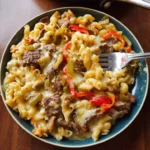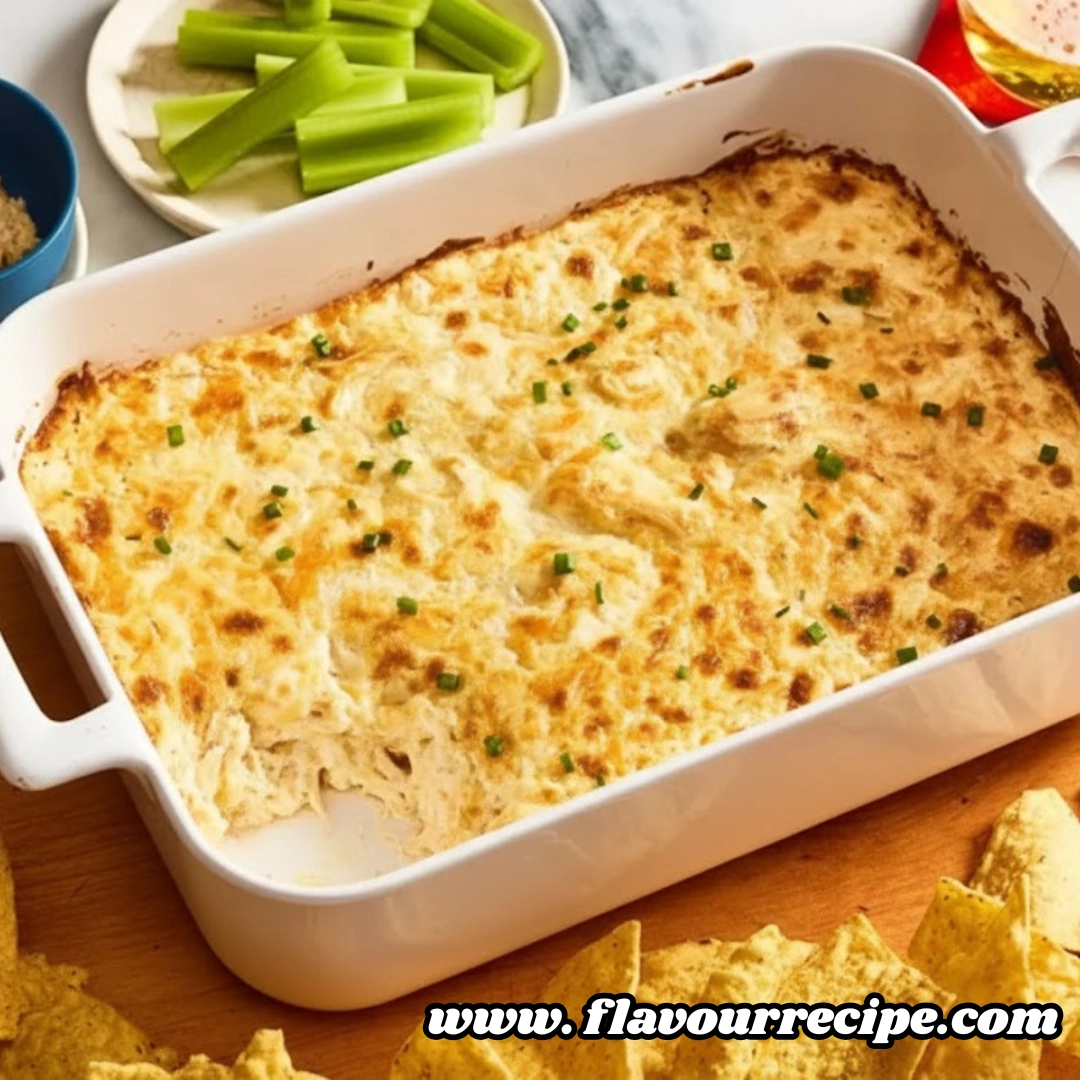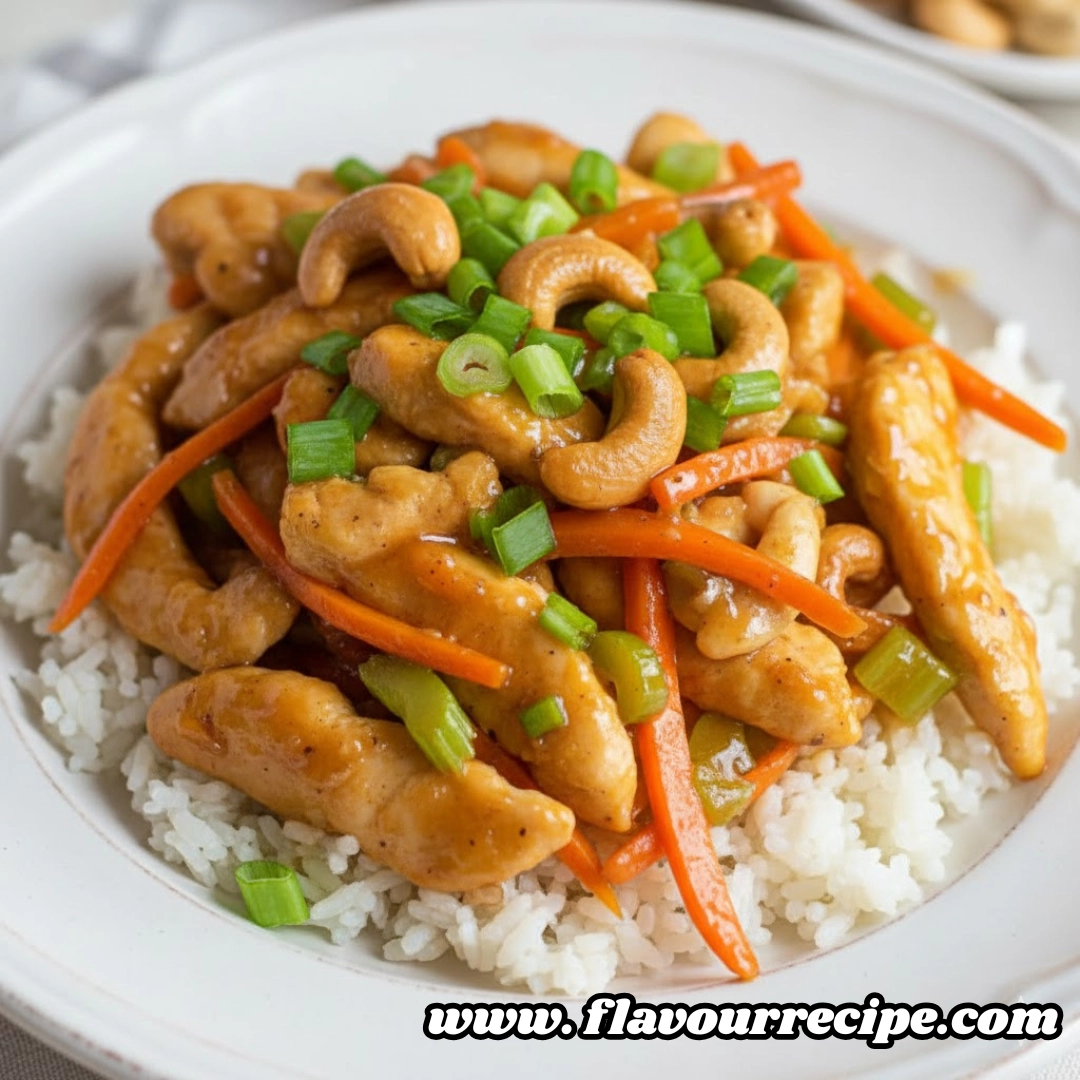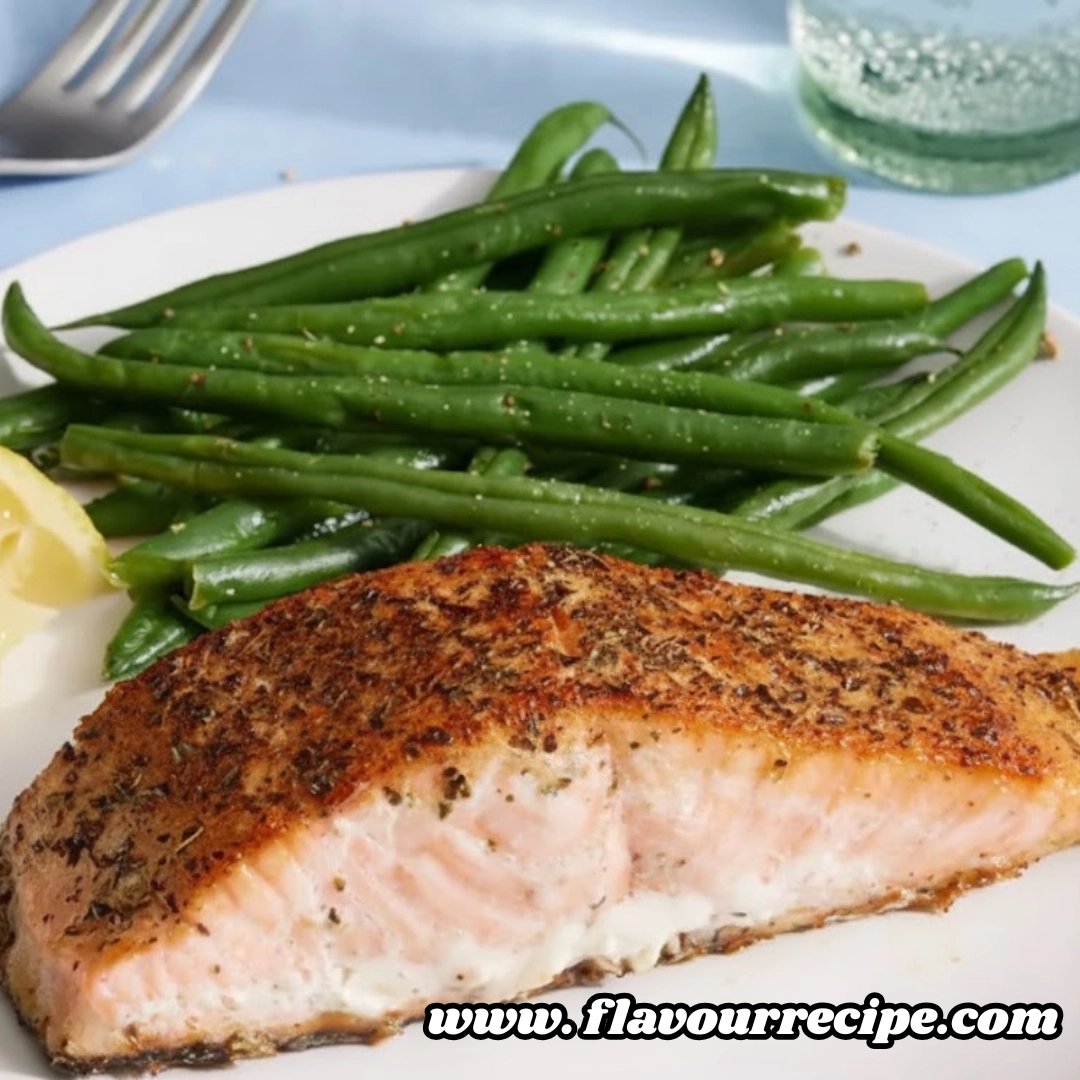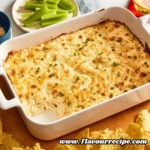Need an easy and satisfying dinner option for a busy weeknight? The philly cheesesteak pasta recipe is the ultimate fusion of hearty comfort and fast, family-friendly cooking. This pasta dish channels the bold, cheesy essence of a classic Philly cheesesteak, all brought together in one delicious skillet meal.
You get tender slices of well-seasoned steak, perfectly cooked pasta, sautéed onions, mushrooms, and colorful bell peppers, all bathed in a creamy provolone sauce that clings to every bite. It’s rich without being heavy, flavorful without being fussy, and ideal for busy nights when you want something special without extra cleanup.
Unlike many complicated dishes, this one-pan meal is straightforward and quick. From prep to plate in about an hour, it’s easy to make, easier to love, and guaranteed to earn a spot in your regular dinner rotation.
Looking for inspiration? Try these irresistible seafood pasta recipes or check out this fresh spaghetti salad idea if you’re planning a full meal lineup.
Table of Contents
What Is a Philly Cheesesteak Pasta Recipe?
The Inspiration Behind the Dish
The philly cheesesteak pasta recipe takes everything you love about the iconic sandwich and reimagines it as a creamy, one-skillet pasta meal. Originally made famous in Philadelphia, the classic cheesesteak features thinly sliced beef, sautéed onions, and melted cheese on a fresh roll. But what happens when you swap out the bread for tender cavatappi pasta and melt provolone into a rich sauce? You get a next-level comfort food that’s both nostalgic and new.
This recipe isn’t just about throwing steak and cheese into pasta. It’s a thoughtfully layered dish that respects the soul of a traditional cheesesteak while offering the creamy bite and heartiness of pasta. With its balanced blend of textures and flavors, it brings home-cooked goodness to the table in just over an hour, making it a go-to for weeknight meals or casual get-togethers.
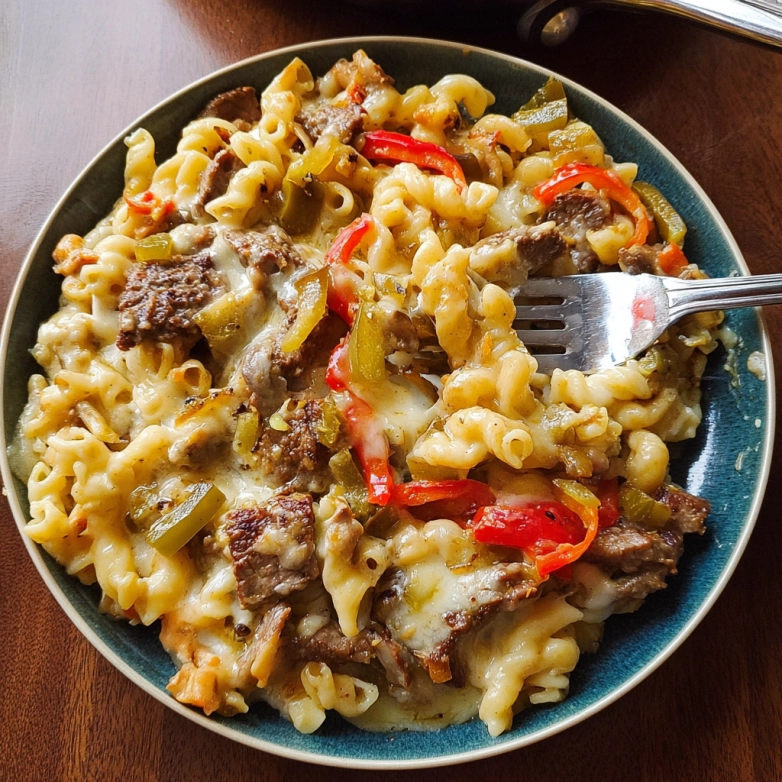
From Sandwich to Skillet, A Comfort Fusion
At its core, the philly cheesesteak pasta recipe is a celebration of two comfort food classics. The steak is sliced thin and seared quickly to lock in flavor. Onions and bell peppers add sweetness and crunch, while mushrooms lend earthiness and depth. All of it simmers gently in a blend of low-sodium beef broth and creamy half-and-half, infusing the pasta with a savory richness that no jarred sauce could ever match.
Once the provolone is stirred in and everything is tossed together, you’re left with a creamy pasta that’s bold and balanced. It’s not overly cheesy or heavy, yet it satisfies in a way that few meals can. If you’ve ever craved a cheesesteak but wanted something more filling and easier to share, this skillet dinner will hit the spot.
Don’t miss our pappardelle pasta recipe for another twist on steak and noodles. Stay tuned for the ingredients list and how to make it step by step in the next section.
Key Ingredients in Philly Cheesesteak Pasta
PrintPhilly Cheesesteak Pasta Recipe That’s Creamy, Cheesy, and Easy to Make
This creamy Philly cheesesteak pasta recipe combines tender steak, sautéed peppers, onions, mushrooms, and provolone cheese in one skillet. It’s the perfect comfort food made easy.
- Prep Time: 20 mins
- Cook Time: 50 mins
- Total Time: 1 hr 10 mins
- Yield: 4 servings
- Category: Dinner
- Method: Stovetop
- Cuisine: American
Ingredients
- 1 lb skirt steak or ribeye, thinly sliced
- 2 tbsp neutral oil
- 1 tsp Italian seasoning
- Kosher salt, to taste
- Fresh ground black pepper, to taste
- 8 oz cremini or white mushrooms, sliced
- 1 medium yellow onion, thinly sliced
- 1 green bell pepper, thinly sliced
- 1 red bell pepper, thinly sliced
- 4 garlic cloves, chopped
- 3 1/2 cups low-sodium beef broth
- 1 cup half-and-half
- 8 oz cavatappi pasta
- 6 oz shredded provolone cheese
Instructions
- 1. Place steak in freezer for 10 minutes, then slice thinly across the grain.
- 2. Toss steak with Italian seasoning, salt, and pepper.
- 3. In a hot skillet with oil, sear steak in a single layer until browned. Remove and set aside.
- 4. In the same skillet, sauté mushrooms until browned. Transfer to bowl with steak.
- 5. Add remaining oil, then sauté onions and bell peppers until softened. Add garlic and cook for 1 minute.
- 6. Pour in beef broth and half-and-half. Bring to a simmer and stir in pasta in a single layer.
- 7. Cover and cook for 10–12 minutes until pasta is al dente and sauce has thickened.
- 8. Stir in provolone cheese until melted.
- 9. Return steak and veggies to skillet and toss until well combined. Serve hot.
Notes
- You can substitute skirt steak with flank steak or thin-sliced chicken breast.
- Use whole-grain pasta for added fiber.
- Refrigerate leftovers in an airtight container for up to 4 days.
- Add jalapeños or chili flakes for a spicy twist.
Nutrition
- Serving Size: 1 bowl
- Calories: 796
- Sugar: 4g
- Sodium: 670mg
- Fat: 32g
- Saturated Fat: 18g
- Unsaturated Fat: 12g
- Trans Fat: 0g
- Carbohydrates: 52g
- Fiber: 3g
- Protein: 34g
- Cholesterol: 95mg
Nutrition Disclaimer: The nutrition information provided in the Recipe card is an estimate only.
For the most accurate results, please calculate the values yourself using your preferred nutrition calculator.
Steak Selection, Skirt, Ribeye, or Flank?
The type of steak you choose plays a huge role in the taste and texture of your philly cheesesteak pasta recipe. Skirt steak is often the go-to because it’s flavorful and tender when sliced thin across the grain. Ribeye is another excellent option, known for its marbling and juicy bite, but flank steak can also work well if you’re looking for a leaner cut.
To make slicing easier, place the steak in the freezer for about 10 minutes before cutting. This technique firms up the meat just enough to let you shave it into those ideal, thin strips that cook fast and absorb flavor beautifully.
No matter the cut, it’s important to season the beef with a generous blend of Italian seasoning, salt, and freshly cracked black pepper. A quick sear in a hot pan locks in flavor, keeps the meat tender, and sets the stage for the rest of the dish.
Creamy Sauce Components, Provolone, Half-and-Half, and Broth
What truly sets this philly cheesesteak pasta recipe apart is its creamy, cheesy sauce. Instead of a traditional red sauce, this recipe calls for a rich base made from low-sodium beef broth and half-and-half. The broth deepens the flavor, while the half-and-half creates a velvety consistency that clings to every twist of cavatappi.
The real magic happens when shredded provolone is stirred in at the end. This cheese melts seamlessly, adding that signature cheesesteak flavor without becoming stringy or overpowering. Provolone is key here, but feel free to blend in mild mozzarella or even a touch of cheddar if you’re customizing.
And don’t overlook the importance of garlic. Four cloves, chopped finely and sautéed with the vegetables, infuse the dish with an irresistible aroma and savory depth. This flavor foundation allows each bite to deliver layers of beefy, cheesy comfort.
Step-by-Step Philly Cheesesteak Pasta Cooking Instructions
Prepping the Steak, Tips for Thin Slices
The secret to tender, flavorful steak in your philly cheesesteak pasta recipe lies in the prep. Start by placing your steak in the freezer for about 10 minutes. This quick chill firms the meat just enough to make slicing easier and more precise. Aim for razor-thin slices across the grain, which helps keep the meat juicy and easy to chew.
Once sliced, toss the steak in a bowl with Italian seasoning, kosher salt, and black pepper. Let it sit for a few minutes while you prep the vegetables. This short marinade allows the seasoning to penetrate and enhances the beef’s natural flavor.
Heat a stainless steel skillet over medium-high and swirl in a tablespoon of neutral oil. Once hot, add the steak in a single layer. Cook undisturbed for about 2 minutes until the underside browns, then stir and continue cooking until just no longer pink. Remove and set aside. Don’t overcrowd the pan, or the steak will steam instead of sear.
Cooking the Pasta and Veggies Together in One Skillet
In the same skillet, reduce the heat to medium and add the mushrooms. Stir occasionally until they start to brown, about 8 to 10 minutes. Lightly season with salt, then transfer them to the bowl with the steak.
Add another tablespoon of oil, then toss in your thinly sliced onions and bell peppers. Cook while stirring for another 8 to 10 minutes until the veggies are soft and fragrant. Add chopped garlic and sauté for just a minute more to release that savory aroma. Move everything to the bowl with the mushrooms and steak.
Now comes the one-pan magic. Pour the beef broth into the skillet, scraping up the browned bits stuck to the bottom. Stir in the half-and-half and bring the mixture to a simmer. Add the cavatappi in a single layer, pressing down lightly to ensure even cooking. Cover the skillet and simmer for 10 to 12 minutes, stirring occasionally, until the pasta is al dente and the sauce has thickened slightly.
Reduce the heat to low and stir in the shredded provolone. Let it melt fully, then return the steak and veggie mixture to the pan. Toss until everything is well coated and heated through. The result is a rich, creamy pasta dish bursting with classic cheesesteak flavor in every bite.
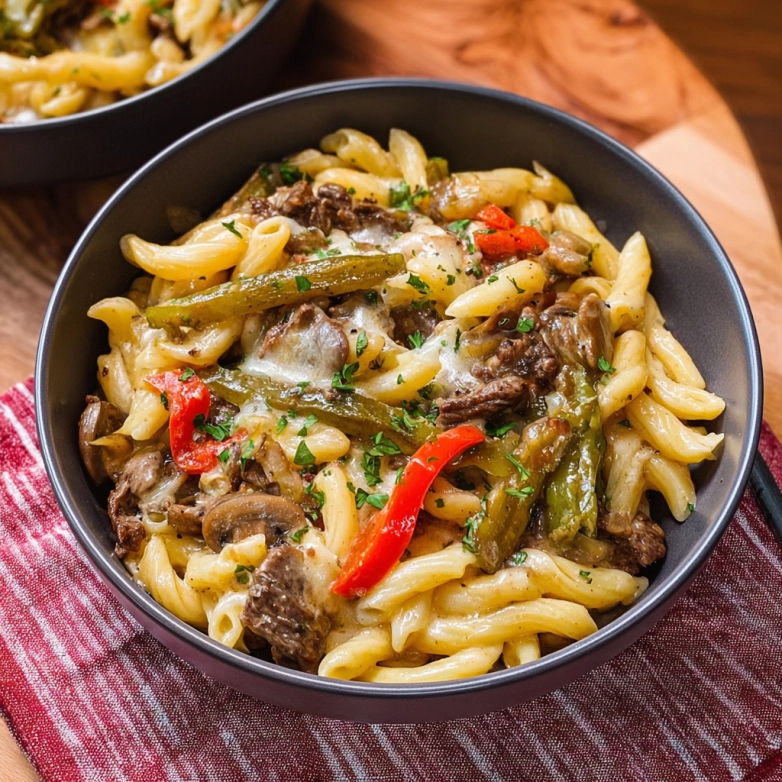
Check out this creamy Tuscan chicken pasta if you’re looking to try another satisfying skillet-style dinner next time.
The Secret Ingredient in Cheesesteak-Style Pasta
What Sets This Recipe Apart?
Every iconic recipe has something extra that gives it that unforgettable taste, and in the case of this philly cheesesteak pasta recipe, it’s the Italian seasoning. While it might seem simple, this spice blend brings just the right amount of herby warmth that balances the richness of the beef and cheese. A mix of oregano, thyme, basil, and rosemary adds complexity without overpowering the other ingredients.
This seasoning is tossed with the raw steak before cooking, allowing the herbs to bloom in the hot oil and flavor every slice of meat. When combined with garlic, sautéed vegetables, and beef broth, the result is a layered, savory profile that captures the essence of a cheesesteak in a whole new format.
Another standout? The garlic. Four fresh cloves, chopped and cooked just until fragrant, provide a deep, mellow base that anchors the entire dish. It ties the steak, cheese, and sauce together with a satisfying aroma and flavor that lingers in the best way.
Enhancing Flavor With Italian Seasoning and Garlic
Italian seasoning doesn’t just make the steak taste better—it amplifies the flavor of the whole dish. When mixed into the cooking oil and combined with garlic, it creates a base that soaks into the mushrooms, onions, and peppers. These vegetables aren’t just fillers. They take on the seasoning and bring balance with their sweetness and bite.
Combined, these two ingredients—Italian seasoning and garlic—form the flavor backbone of the recipe. They elevate each bite of pasta without needing extra sauces or artificial flavorings. This is comfort food done right. It’s rich, flavorful, and deeply satisfying without being complicated.
The Best Sauce for Philly Cheesesteak Pasta
Why Beef Broth and Half-and-Half Make Magic
When it comes to building a sauce that’s both rich and balanced, this philly cheesesteak pasta recipe doesn’t rely on shortcuts. It starts with beef broth, which provides depth and umami, bringing out the savory notes of the steak and mushrooms. Low-sodium broth is the best choice here because it gives you control over the seasoning and prevents the dish from tasting overly salty.
Half-and-half steps in to deliver that signature creamy texture. Unlike heavy cream, it keeps the dish rich without making it feel too heavy. Once it simmers with the broth and pasta, the liquid thickens naturally, soaking into the noodles and concentrating all the skillet’s layered flavors.
There’s no need for flour or cornstarch. The starch from the pasta, as it cooks, naturally helps thicken the sauce. This creates a coating that clings to every piece of pasta and makes each bite full of meaty, creamy flavor.
Melting Provolone, Creamy, Savory, Irresistible
The finishing touch to the sauce is provolone cheese. Once the pasta is al dente and the liquid has thickened, shredded provolone is stirred in gently until melted. Provolone has a mellow, nutty flavor and melts like a dream. It’s not greasy or stringy, making it perfect for this pasta skillet.
The cheese combines with the broth and half-and-half to create a velvety coating that wraps around the beef, veggies, and pasta. It doesn’t just sit on top—it becomes part of the sauce. This makes every forkful taste like a perfect bite of cheesesteak, pasta, and creamy richness all in one.

This sauce is what ties the whole dish together. It’s not too thick, not too runny, and hits that perfect savory note that keeps you going back for more.
What to Eat With Philly Cheesesteak Pasta
Side Dishes to Complement the Skillet
The philly cheesesteak pasta recipe is a satisfying dish all on its own, but pairing it with the right sides can take your meal from great to unforgettable. Since the pasta is rich and savory, light and crisp sides work best to balance it out.
A simple green salad with a tangy vinaigrette adds freshness and cuts through the creamy sauce. Think mixed greens with cucumbers, cherry tomatoes, and a splash of lemon juice or balsamic dressing. You can also go for a roasted vegetable medley—zucchini, carrots, or asparagus seasoned lightly with herbs and olive oil.
Garlic bread or toasted baguette slices can be a tasty addition, offering a crunchy contrast and perfect for scooping up any leftover sauce. If you’re hosting guests or feeding a crowd, serve the pasta alongside grilled corn on the cob or a cucumber tomato salad for a refreshing, colorful plate.
Don’t miss our original spaghetti salad recipe for a light and zesty pairing that fits beautifully with the creamy pasta.
Beverage Pairings for a Full Meal
To complete the experience, go for drinks that refresh and cleanse the palate. Iced lemon tea, sparkling water with citrus slices, or a cool cucumber-mint drink can all balance the richness of the pasta. For a cozy night in, a glass of cold apple cider or a fizzy non-alcoholic beverage like ginger ale with lime can elevate the meal without overpowering the flavors.
Customization Ideas for Philly Cheesesteak Pasta
Adding Heat, Spicy Peppers, Jalapeños, or Red Chili Flakes
Want to kick up the flavor? It’s easy to add a bit of spice to your philly cheesesteak pasta recipe without losing its classic comfort appeal. You can finely slice fresh jalapeños and sauté them along with the bell peppers and onions for a little heat in every bite. If you prefer to keep things mild but still crave a spark, a pinch of red chili flakes stirred into the sauce can deliver that perfect warmth.
Spicy banana peppers or a touch of hot sauce are other options if you want a bold kick. Add them gradually and taste as you go, so the heat complements rather than overwhelms the dish. Spice lovers can even sprinkle crushed chili oil on top just before serving for an extra layer of depth.
Making It Healthier, Lean Proteins, Whole-Grain Pasta, and Veggie Swaps
If you’re aiming to make this recipe a bit lighter without sacrificing flavor, small swaps go a long way. First, choose a lean cut of steak or substitute with thinly sliced chicken breast or ground turkey for a lower-fat option. These proteins still soak up the seasoning and sauce beautifully.
Whole-grain pasta or protein-enriched pasta options like chickpea or lentil-based noodles offer more fiber and nutrients. They also hold up well in creamy sauces and give a subtle nutty flavor that pairs well with the provolone and veggies.
For more vegetables in the mix, try swapping out half the pasta for roasted cauliflower florets or sliced zucchini. These low-carb alternatives absorb the sauce nicely and still give that comfort food satisfaction.
Looking for inspiration? Try this pappardelle pasta variation where wide noodles and sautéed vegetables create a fresh, filling combo.
Storage, Leftovers & Meal Prep Tips
How to Store and Reheat Properly
This philly cheesesteak pasta recipe makes a hearty batch, and the good news is that it stores beautifully. Once the pasta has cooled to room temperature, transfer it to an airtight container and refrigerate. It will keep well for up to 4 days without losing flavor or texture.
To reheat, place a portion in a skillet with a splash of water or a bit of half-and-half to revive the creamy texture. Warm it over medium-low heat while stirring gently until everything is hot and smooth again. You can also microwave individual portions in 30-second intervals, stirring in between for even heating.
Avoid reheating on high heat, especially in the microwave, as it can dry out the sauce and make the pasta rubbery. Keeping the temperature moderate helps preserve the tenderness of the steak and the richness of the provolone sauce.
Make-Ahead and Freezer-Friendly Options
If you’re planning meals for the week or looking to batch cook, this recipe is a solid option. Prepare everything as directed but slightly undercook the pasta—this prevents it from becoming too soft when reheated later. Let the dish cool completely before freezing.
Divide into freezer-safe containers or bags in single-serving portions. Flattening the bags can help save space in the freezer. When you’re ready to enjoy, thaw in the fridge overnight and reheat in a skillet for best results.
For meal prep, you can also chop all the vegetables and slice the steak a day ahead. Store them in the fridge so when dinner time rolls around, everything is ready to toss in the pan. This approach cuts prep time in half and keeps the process stress-free.
Common Mistakes to Avoid in Philly Cheesesteak Pasta Recipes
Overcooking the Steak
One of the most common missteps in preparing a philly cheesesteak pasta recipe is overcooking the steak. Thin slices of steak cook fast—usually just 2 to 3 minutes total. Leaving the meat in the skillet too long can make it tough and chewy, which affects the whole texture of the dish.
To prevent this, sear the steak quickly over medium-high heat. Make sure the pan is hot before the meat hits the surface, and avoid stirring too much. Letting it brown on one side before flipping locks in flavor and gives that slightly crisp edge that mimics the original cheesesteak texture. Once it’s no longer pink, get it out of the pan and set it aside to rest while you prepare the vegetables and sauce.
Choosing the Wrong Pasta Type
Another easy mistake is using the wrong pasta shape. While any pasta can technically work, short, ridged pasta like cavatappi, rotini, or penne is best. These shapes hold onto the creamy sauce and small bits of steak and veggies, giving you balanced flavor in every bite.
Avoid using long noodles like spaghetti or linguine, as they don’t mix well with chunky ingredients like sliced steak and peppers. Also, very small pasta shapes can get lost in the sauce and lose their impact.
Cook the pasta to al dente, and let it finish in the skillet as it simmers with the sauce. This allows the noodles to soak up the beefy broth and creamy base, making them extra flavorful and well-integrated into the dish.
Conclusion
The philly cheesesteak pasta recipe blends everything we love about classic comfort food into one creamy, cheesy skillet dish. With perfectly seared steak, sautéed vegetables, and a provolone-rich sauce wrapped around tender pasta, this meal is hearty, satisfying, and made for sharing.
Whether you’re cooking for a busy family night or prepping meals ahead of time, this recipe adapts easily. You can keep it traditional or customize it with spicy peppers, lean proteins, and whole-grain pasta to suit your taste.
Don’t miss our collection of seafood pasta recipes for more comforting one-pan ideas.
Craving easy, delicious recipes?
Don’t miss a single bite—follow us on Facebook for daily comfort food favorites, quick dinner ideas, and tasty inspiration: Flavour Recipe on Facebook
Join us on Pinterest for stunning food boards, smart meal prep tips, and family-loved classics: Flavour Recipe on Pinterest
Let’s whip up something amazing together!
Philly Cheesesteak Pasta Questions Answered
What is the secret ingredient in cheesesteak?
While traditional cheesesteak recipes are known for their simplicity, the real flavor punch often comes from the right seasoning. In this philly cheesesteak pasta recipe, Italian seasoning is the subtle yet powerful secret ingredient. It adds depth with herbs like oregano and basil, enhancing the beef and cheese combination without overwhelming it.
What kind of sauce is used for Philly cheesesteak?
Classic Philly cheesesteaks usually don’t include a formal sauce, but in this pasta twist, the sauce is a standout feature. It’s made from low-sodium beef broth and half-and-half, then finished with melted provolone cheese. This combination creates a rich, creamy, and savory sauce that mimics the cheesiness of the original sandwich but works perfectly with pasta.
What to eat with Philly cheesesteak pasta?
This dish pairs well with simple, refreshing sides. A green salad with lemon vinaigrette, roasted vegetables, or garlic bread makes a great contrast to the creamy richness of the pasta. You can also serve it with a crisp cucumber-tomato salad or a cold drink like iced tea or sparkling water to complete the meal.
What are the ingredients for Philly cheesesteak?
A classic Philly cheesesteak includes thinly sliced steak, onions, and melted cheese (often provolone, American, or cheese spread). In the pasta version, you’ll also find cavatappi pasta, bell peppers, mushrooms, garlic, beef broth, and half-and-half. These ingredients come together to deliver all the signature flavors of the sandwich in a comforting pasta form.

